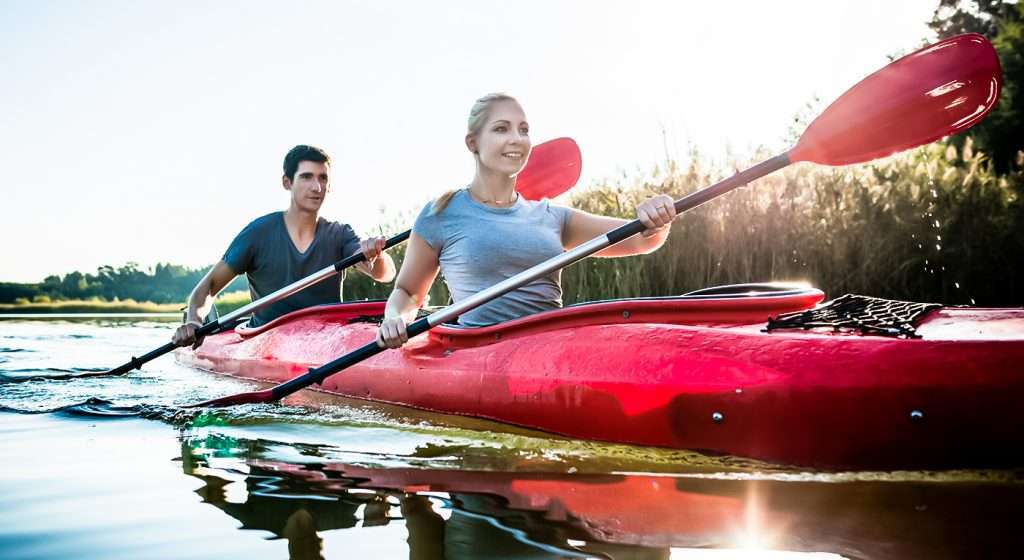You have given a lot of thought to getting the right inflatable kayak. Paddles are also important gear to shop for and the decision of what to buy is a relatively easy one to make.
If you are renting an inflatable kayak, you won’t have much choice of a paddle since most any paddle they give you will get the job done. Once you have decided to invest in your own boat, the paddle choice will be a matter of your kayaking style plus the paddle’s length, blade symmetry, materials used, and price.
Paddle Length
The first criteria when choosing an inflatable kayak paddle will depend on your height and the type of kayaking you will do. IKs tend to be wider than hard shell kayaks so paddles will be a bit longer to compensate for the large tubes. As a general rule, touring & recreational IK paddles are 220 to 240 cm long (94.5 inches), and play boat & whitewater IK paddles are around 210 cm long (83 inches).
It is recommended that you get a paddle that conforms to your height: a person under 5’2″ can use a 220 cm length; 5’0″ to 5’8″ can use any paddle up to 230 cm; and people over 5’6″ can use a paddle as long as 240 cm.
As with other sports tools, such as baseball bats or ski poles, you may find you prefer a shorter paddle than what is recommended by standardized charts. It will also depend on your stroke style: do you have an upright or high angle paddle stroke, or a relaxed, low angle sweeping stroke? Your best bet is to try a couple of lengths before you buy.
Paddle Shape
Along with the length, paddles vary in the style of the blade and the shaft. More advanced inflatable kayak paddles have bent shafts that are more comfortable for paddling, but the majority use a more economical straight shaft. The shaft will usually feature a foam grip for added comfort for your hands.
Most kayak paddle blades are shaped asymmetrical, which provides for a better paddling experience over symmetrical blades. The paddle’s shaft is adjustable allowing for different feather angles; that is, the angle of the blades can be offset from each other with multiple feather settings up to 45 degrees.
For best results, look for blades that are spooned (curved) to give you the best pulling results in the water. That design won’t strain your arms and shoulders as much as a flat face blade will.
Paddle Blade
The blade is the part of the paddle that actually moves through the water. The shape of the blade will determine how much power you can generate with each stroke. There are three main types of paddle blades: flat, curved, and asymmetrical.
- Flat blades are the most common type of paddle blade and are typically used for recreational kayaking. They offer a good balance of power and control.
- Curved blades are less common but can offer more power. They are typically used for whitewater kayaking where more power is needed to navigate through rapids.
- Asymmetrical blades are the least common type of paddle blade. They are designed to offer more power on one side of the blade than the other. This can be helpful for kayakers who paddle with one hand or for those who want to generate more power on one side of their body.
Paddle Grip
The grip is the part of the paddle that you hold onto while paddling. There are two main types of paddle grips: T-grips and pistol grips.
- T-grips are the most common type of grip and offer a good balance of comfort and control.
- Pistol grips are less common but can offer more comfort for those who paddle with one hand or those who want to generate more power on one side of their body.
Materials and Price Factors
The last few items to review will be the quality of the materials used in inflatable kayak paddles which will be reflected in the price.
Paddles for inflatable and hard-shell kayaks are made from anodized aluminum, fiberglass, plastic, carbon, and reinforced nylon, or a combination of materials. These will be heavier, but less costly paddles. The most expensive paddles are made from graphite composites, can weigh less than 8 ounces, and can cost anywhere from $300 to $500. The high-performance, ultra-lightweight paddles feature bent shafts ranging from 6.5 to 7.25 inches in diameter, foam core blades, and will be flawlessly balanced.
The Final Decision: Cost
When you review brand name kayak paddles, pay attention to the length and weight. The under $40 paddles are capable of getting the job done; they are portable (they break down into two sections for convenient stowing), and you can adjust the blade angles for either standard or asymmetrical (offset) paddling. The only drawback is that cheaper paddles are heavy, weighing around 2 ½ to 3 pounds. That may not sound like a big deal, but it is after you’ve paddled for several hours and your wrist and arms are feeling the burn.
A cheap paddle will feel like a clunker in your hands, but it will have to do until you can invest in a better one. The sweet spot, or best value for price and durability for quality inflatable kayak paddles, is in the $80 to $150 range. Get the best paddle you can afford, but remember, overkill isn’t necessary. There’s always the slim chance your pricey paddle investment can float down the river and get away from you.

